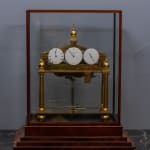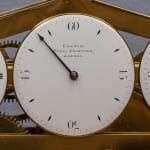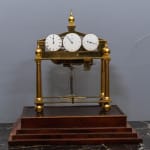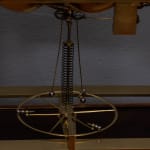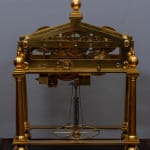James Moore French
A REGENCY GILT BRASS SKELETON CLOCK, London, first half of the nineteenth century
Height 37 cm, width 27 cm, depth 15 cm.
Further images
An extremely rare Regency gilt brass skeleton clock by James Moore French of eight days duration, signed on the central white enamel minute dial French, Royal Exchange, London. The clock featuring three dials, the one to the left with Roman numerals for the hours, the one at centre with Arabic numerals 15/30/45/60 for the minutes and the one to the right, again with Arabic numerals 15/30/45/60 for the seconds, each dial with a blued steel pointer. The skeletonised movement with a savage escapement, the wheels, each with six spokes that mesh directly instead of having pinions, with a horizontally aligned escape wheel with six spokes, a 3½ inch balance wheel with three arms that carry the rating nuts and a helical spring, the small wheel at the top of the balance arbor carrying two impulse pins that engage the fork of the pallets, the two carved wires with steel balls on their ends acting as a governor to prevent over-banking. The brass open framed case shaped as a classical temple surmounted by a ball and spire finial on a stepped base, with a pedimented top on which the hour, minute and seconds dials are attached, the top supported on a rectangular platform above fluted pilaster columns at each corner, the four pilasters surmounted by a ball and spire finial, with an angular stretcher at the base of the pilasters that are raised on ball feet and are supported upon a surrounding rectangular stepped mahogany base, housed in its original rectangular mahogany framed glass case
London, first half of the nineteenth century
Height 37 cm, width 27 cm, depth 15 cm.
Literature: F. B. Royer-Collard, “Skeleton Clocks” 1981, pl. 10-8, illustrating an almost identical skeleton clock, inscribed on a plaque with the name of Robert Roskell of Liverpool.
This fascinating and highly unusual clock was made by James Moore French (1781-1842), who made his name and repute in London as a fine watch, clock and chronometer maker and became a Freeman of the Clockmakers Company by redemption in 1810. Before discussing this gifted maker in more detail, it is worth describing the clock itself since it is a rare horological work of art. Its design was inspired or based on the famous rolling ball clock patented by Sir William Congreve in 1808, of which the original model made by Gravel and Tolkein was presented to the Prince of Wales in the same year and is now in the Rotunda building of the Royal Artillery Museum at the Woolwich Arsenal at Greenwich. Congreve’s rolling ball clock incorporates a ball rolling down a zigzag grooved tray as a means to determine the rate at which the clock runs. The grooved tray is set within an open brass frame, which as here features at each corner columnar supports with ball and spire finials and also incorporates three dial rings mounted on a pedimented structure above.
Congreve’s clock was copied by many clockmakers during the nineteenth and twentieth centuries, including the firms of Dent, Thwaites & Reed and Frodsham. Significantly another maker to have been similarly inspired was our clockmaker, James Moore French. His version of Congreve’s rolling ball clock, which was made in about 1830, was once in the renowned Ilbert Collection and is now in the British Museum, London. There are very close similarities between the overall design of French’s rolling ball clock and his present skeleton clock. The example in the British Museum features three dial rings, as opposed to this clock which has three solid white enamel dials. However, in each instance the three dials or dials rings are mounted on the pedimented top beneath a ball and spire finial, while the main open rectangular brass frame is supported by four columns with ball and spire finials and ball feet, which rest on a wooden base and are housed within their original wood and glass covers. Interestingly the cover of French’s clock in the British Museum is housed in a Sheraton satinwood glazed cover with a domed top which, as here, has an almost identical surrounding stepped base. Of course, the obvious and most significant difference between James Moore French’s rolling ball clock and the present example is the clock’s skeletonised movement, which is fascinating to observe when operating in motion.
Another skeleton clock that is very similar to the present example is engraved with the name of Robert Roskell of Liverpool on a plaque below the three white enamel dials (illustrated in F. B. Royer-Collard, “Skeleton Clocks” 1981, pl. 10-8). Like James Moore French, Robert Roskell (c.1790-65), was a clock, watch and chronometer maker of repute, so it is difficult to determine whether in that instance he was the maker or simply the retailer of a clock made by James Moore French. However, since the present example is signed on one of the dials rather than on a subsidiary plaque, it seems more likely that Roskell was retailing a work that had been made in London by James Moore French.
James Moore French was born in 1781 in County Antrim, Ireland. He was the son of Dr Hugh French and Sarah (née Arundel) French who married his father in 1763 and died in 1783, two years after James’s birth. In 1784, the year after Sarah’s death, Dr Hugh French married a widow named Judith Woodward who was to raise the young James French as her own, alongside his own and his half siblings. As a young man, James French moved from Ireland to London, where he worked with a relative, Peter Moore, who was a watch and clockmaker based at 15 Sweetings Alley, just off Cornhill on the eastern side of the Royal Exchange, in the City of London.
In 1810 French was admitted to the Worshipful Company of Clockmakers, by which time he appears to have taken over Moore’s business and premises, commencing trading as James Moore French of Sweetings Alley. Certainly, we know that he was trading from 15 Sweetings Alley from 1808 until about 1838. A London trade directory dated 1829 has a listing for J. M. Moore advertising as a chronometer maker at 14 and 15 East side of Royal Exchange (i.e., Sweetings Alley). By 1839 he had moved to 18 Cornhill and is also recorded at 86 Cornhill, during 1839-40, and from 1841 up until his death in 1842 at 80 Cornhill. It seems that in 1825, and for a short time, he was in partnership with Mr. Mitchell at 5 Clerkenwell Close, when they traded under the name of Mitchell & French. On other occasions, he was referred to under the name of Santiago James Moore French or simply Santiago Moore French, particularly when trading clocks with Spain.
During the 1820s, James Moore French diversified into the manufacture of marine chronometers, at which he excelled, winning various prizes from the Board of Longitude. For instance, he submitted chronometers to the trials at the Royal Observatory Greenwich between 1822 and 1825, winning two Admiralty prizes in 1825, while George Cruikshank’s portrait engraving of him, showing him proudly standing beside one of his prize chronometers, (published in 1827; of which there is an example in the British Museum, London), is titled below The Royal Exchange Triple Prize Chronometer. Furthermore, his chronometer no 4214 was used on one of Charles Darwin’s voyages on HMS Beagle (Darwin being the famous author of On the Origin of Species).
For a period, James Moore French lived in Islington and then later at Perry Hill House, near Lewisham, a beautiful late eighteenth century mansion, set in its own parkland. By the time of the 1841 census, he was living in Stockwell Place with his wife Elizabeth and a number of their children. They had at least six offspring of whom John and William followed their father’s profession and who, according to his will, were left his business after his death. James Moore French died in late January 1842, and was buried on 3rd February 1842, in Norwood Cemetery, south London. Even though his will stated that he was to leave the business to his sons William and John, it appears that it was continued by his widow and the Spanish-born clockmaker Jose Rodriguez Losada, who had previously worked for French and later married his widow. Under Losada, the firm continued to produce many fine clocks and chronometers selling, in 1864, thirty-eight examples to the Spanish government after successfully competing in trials. During this period the shop in Cornhill (called The City Observatory) was equipped with a large time ball which received signals from the Electric Telegraph Company to enable the public to check their watches. A picture of French’s shop and time ball appears in Vaudrey Mercer’s biography of the renowned clockmaker Edward John Dent and his successors.
1
of
6





